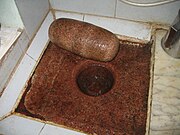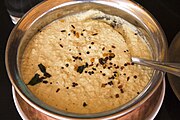From Wikipedia, the free encyclopedia

Chutney (Hindi: चटनी; Urdu: چٹنی ) (British spelling) or chatni (Hindi, Urdu, Bengali or Tamil - சட்னி transliteration) is a term for a variety of sweet and spicy condiments, originally from the South Asia usually involving a fresh, chopped primary vegetable or fruit with added seasonings. Chutney, as a genre, is often similar to the Indian pickle and the salsa of Latin American cuisine, or European relish.
Chutney may be dry or wet; dry chutney is generally in the form of powder. In India, a chutney is often made to be eaten fresh, using whatever suitable strongly flavoured ingredients are locally traditional or available at the time. It would not normally contain preserving agents, since it is intended to be consumed soon after preparation. The Hindi translation of "to make chutney" is a common idiom meaning "to crush". This is because the process of making chutney often involves the crushing together of the ingredients.[citation needed]
The use of a stone mortar and pestle is often regarded as vital to create the ideal chutney. It consists of a small stone bowl (called a "kharal" or "khal" in Hindi, Tamil kal கல்), or a flat piece of stone (called a "sil") on which the ingredients are crushed together with a rounded stick of stone or wood (called a "batta", pronounced with a hard 't').
Chutney is more familiar in North America and Europe in a form that can be stored. To this end, vegetable oil, vinegar, or lemon juice are used to enhance the keeping properties.
Types of chutney
Many authentic chutneys contain significant amounts of fresh green chili peppers; the other main ingredient can be any of a wide variety of fruits and vegetables. Most vegetable chutneys are prepared cold in a blender, while many fruit chutneys do require cooking. Popular chutneys include:
- Coconut chutney
- Onion chutney
- Tomato chutney
- Coriander (Cilantro) and/or mint chutney (both are often called Hari chutney, where 'Hari' is Hindi for 'Green')
- Tamarind chutney (Imli chutney)
- Mango chutney (made from unripe, green mangos)
- Lime chutney (made from whole, unripe limes)
- Garlic chutney made from fresh garlic, coconut and groundnut
- Green tomato chutney. Common English recipe to use up unripe tomatoes
- Peach Chutney, predominantly in South African Mrs Ball's Chutney
- Chilli Chutney, predominantly in South African Mrs Ball's Chutney
- Peanut chutney (shenga chutney in marathi)
In temperate countries, chutneys are sometimes made using local main ingredients such as apples, peaches or tomatoes.
American and European styled chutneys are usually fruit, vinegar and sugar, cooked down to a reduction.
Flavourings are always added to the mix. These may include sugar, salt, garlic, tamarind, onion, or ginger.
Spices most commonly include fenugreek, coriander, cumin and asafoetida (hing).
Etymology
The word chutney is derived from synonymous Persian chāshni (چاشنى) which has originated from Middle Persian Pahlavi of çāshnik, sharing the same root with other Persian words such as chāsht (چاشت) meaning a portion of food. [1]
History
Beginning in the 1600 chutneys were shipped to European countries like England and France as luxury goods. Western imitations were called "mangoed" fruits or vegetables. In the nineteenth century, brands of chutney like Major Grey's or Bengal Club created for Western tastes were shipped to Europe.
Generally these chutneys are fruit, vinegar and sugar cooked down to a reduction.
The tradition of chutney making spread throughout the British empire, especially in the Caribbean and American South where chutney is still a popular condiment for ham, pork and fish.
Chutney by Indian region
- Assam - coriander, spinach, tomato, curry leaf, chilli, radish, carrot, cucumber, beetroot, lentil, chickpea chutneys
- Andhra Pradesh — coconut, coriander, red chilli with grams, tomato, onion, and mango chutneys
- Gujarat — athanah and hot lime chutneys
- Haryana — tamarind chutney
- Himachal Pradesh — guava and eggplant chutneys
- Karnataka — coconut, coriander, green chili, mango, onion, peanut, tomato, tamarind,ridgegourd.
- Kerala — coconut, pudina (mint), urad dal (a kind of legume), mango, dry fish, shrimp, and onion chutney
- Maharashtra — hot raw mango chutney, guramba,panchamrit,Mirachicha Thecha. Dry chutneys made with Javas (Flax seed),Solapuri Shenga(peanut)/red chili powder chutney, Karale (Niger seed)and Peanut/garlic
- Punjab — pudina (mint) chutney, onion chutney, tamarind chutney, mango chutney
- Tamil Nadu — coconut, coriander, red chilli with grams, tomato, onion, and mango chutneys
- Uttar Pradesh — coriander, garlic, mint chutney, sweet and sour mango, and peanut
- West Bengal — fruit (mango, plum, apple, and apricot) chutneys
- Nepal — (tomato, potato), chutneys


















No comments:
Post a Comment